Rising
Victor Oladipo, Indiana, 6’4”, SG
It was just a few months ago we were questioning whether or not Victor Oladipo would ever have an NBA future. Now we’re trying to figure out who’s going to target him in the lottery.
He’s matching productivity with efficiency, scoring 14 points on 63 percent shooting, numbers that reflect a center, not an off-guard. He’s getting to the rim and changing directions on the way, and knocking down spot-up jumpers when the opportunity presents itself.
With lockdown defensive tools including a relentless motor and elite athleticism, Oladipo can now be considered more than just a defensive specialist, but an offensive threat and a two-way, lottery prospect.
Ben McLemore, Kansas, 6’5”, SG
McLemore went nuts against West Virginia, scoring 36 points in his most complete offensive performance of the year. He showed off more than just the spot-up jumper by putting the ball on the floor and either getting to the hole or pulling up off the dribble.
Usually you find that the best athletes are the worst shooters, but McLemore breaks that trend. With ideal physical tools for the shooting guard position, top-shelf accuracy on his jumper and the ability to play above the rim, there just aren’t any question marks with regard to the transition process.
If he develops more as a shot-creator, he’s got all the tools to justify first pick overall value in a draft with minimal star power.
Otto Porter, Georgetown, 6’8”, SF
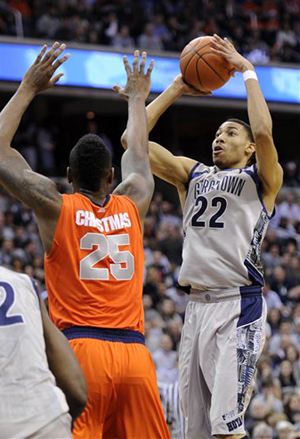
He’s putting up big scoring games, like 33 on Syracuse, 28 on Rutgers and 23 on UConn (including the game-winner in OT), despite not having an advancing shot-creating arsenal.
Because Porter can score on the move as a slasher, in the mid-range and spotting up from downtown, he’s able to average 16 points per game off the ball without ever disrupting the offensive rhythm.
The reliability he offers should solidify his status as a lottery prospect at the very least, and has him moving all the way up to #3 on the latest mock draft.
Marcus Smart Oklahoma State, 6’4”, PG/SG
Though Marcus Smart contributes across the board on the box score, scouts won’t be looking at his statistics. He’s got that rare quality that can’t be replicated, showing the ability to make his teammates better as Oklahoma State’s floor general.
Smart is built like a 2 from the neck down, but has the head and brains of a pass-first orchestrator. He’s over a year younger than Ben McLemore yet wins the battle of on-court confidence and maturity.
This is a guy coaches and teammates trust with the ball in his hands to make the right play at the right time. If the team who wins the lottery is searching for a new lead guard, Smart wouldn’t be a bad option. He’s excelled at every level and there’s no reason to think that will change in the NBA.
Markel Brown, Oklahoma State, 6’3”, SG
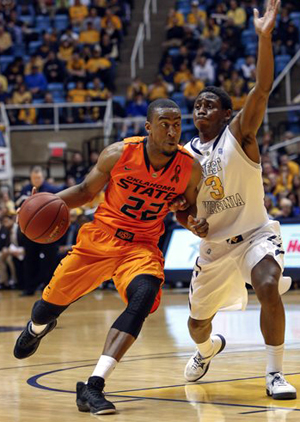
He’s undersized for an NBA 2-guard, but with elite athleticism, he projects as an energy combo guard. Brown has the tools to defend opposing point guards, and with a much improved offensive repertoire, he’s put himself on NBA radars.
Leading the Cowboys in scoring, Brown has moved up to #19 on the 2013 NBA mock draft board.
Nate Wolters, South Dakota State, 6’4”, PG
It’s just too hard to ignore what Nate Wolters is doing at South Dakota State.
In terms of creating scoring opportunities off the dribble, I’m not sure there’s anyone better. At South Dakota State where his supporting cast is lacking, it just so happens he’s creating for himself. Wolters went for 53, 36, 28 and 32, all in a two week span during February. He’s averaging nearly 6 assists to go with his 22 points per game, illustrating his ability to generate offense as either a scorer or distributor.
He’s also got his 3-point percentage up above 40 percent, a promise sign considering he only shot 24 percent from downtown as a junior.
Wolters projects as a backup point guard who can make up for a lack of athleticism with good size for the position. I don’t think it’s crazy to think a team like the Knicks could target his services at the end of round 1.
We currently have him as a top pick of the 2013 second round.
Myck Kabongo, Texas, 6’2”, PG
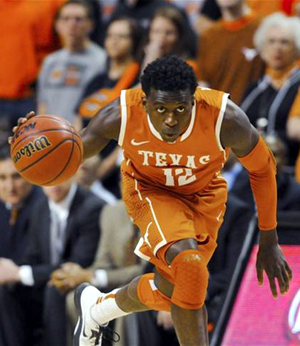
Kabongo scored 31 in an overtime win over Oklahoma, after nailing a wild buzzer-beater at the end of regulation, and is recently coming off a 19-point and 8-assist game in a win over Baylor. He’s moved into our mid-to-late 2013 first round.
Adreian Payne, Michigan St, 6’10”, PF
Adreian Payne has always been on NBA radars because of his athleticism, incredible wingspan and deceptive mobility. But he never had the skill set that put his physical tools to good use.
Not only is he now dominating the paint but he’s expanded his game out to the three-point arc. Payne’s confidence is sky-high and it’s positively affected his productivity.
Another year at Michigan State will allow him to work more on his in-between game, post moves and three-ball to maximize his value as an NBA prospect.
Mike Muscala, Bucknell, 6’11”, PF/C
It’s not even that Muscala is averaging 19 and 11, it’s how he’s getting those numbers. Muscala has an NBA skill set with the ability to score deep in the post or step out in the mid-range and knock down the face-up jumper with consistency.
With excellent size and adequate strength, Muscala projects as a reliable inside/outside presence. A playoff team who can use his strengths in a limited role might be inclined to burn a late first rounder on Muscala, who has the size, talent and IQ to make the transition.
Falling
Anthony Bennett, UNLV, 6’7", PF
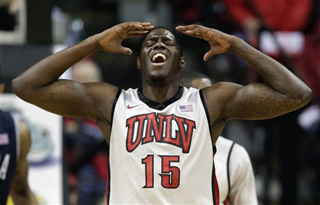
Injuries had been Bennett’s bugaboo throughout his high school basketball career and making through the entire year unscathed had him in discussion to be a top 3 pick and even garnering some #1 overall consideration. But with his dropoff in production and late season injuries, he has slipped some in many scout’s minds.
He’s struggling to create easy scoring opportunities for himself with the ball in his hands, and if the ball isn’t given to him in the right spot, he’s vulnerable to disappearing through stretches offensively. The injury bug appears to have hit him, and it appears that he can;t wait for the season to end.
His upside still justifies top 10 value, but he’s on the decline, falling out of the top 5 area.
Shabazz Muhammad, UCLA, 6’6”, SF
Though Muhammad is stroking the ball from deep better than anyone anticipated, most of it is coming as a catch and shooter. We haven’t seen much dribble creativity, particularly as a perimeter scorer. Many of his points come off unorthodox one-handed push shots, using his instincts and feel for the rim to convert at awkward angles.
It would be nice to see him create offense via the pull-up or step-back jumper, a tool that typically translates and propels scorers to the next level.
Muhammad has fallen to 5-6 range over the past few weeks.
Michael Carter-Williams, Syracuse, 6’6" PG
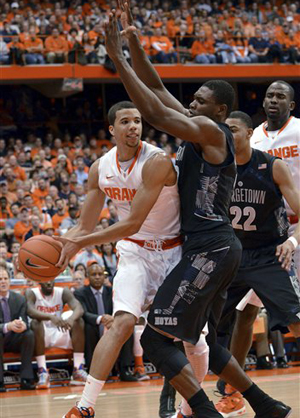
Carter-Williams has failed to put up 20 points in a game all year, his shooting numbers have dipped considerably to just 39% from the field and 28% from 3.
Another negative is that the sophomore point is the age of a senior. Due to being born in 1991, his upside will come under question.
MCW benefits from the fact that it’s a weak draft and he has perceived upside due to his great size at the PG position. But if he doesn’t turn things up quickly he could end up being the fourth PG off the board on draft night with Marcus Smart, Trey Burke and CJ McCollum all going before him.
Alex Poythress, Kentucky, 6’7”, PF
There’s no denying Poythress is a strong finisher at the rim, but unless the table is set for him, he’s unlikely to generate his own offense. Poythress isn’t much of a threat off the dribble, with limited ballhandling and an inability to change directions which leads to contested shots in the half court.
Right now he’s just an athlete with size, strength and explosiveness. He needs to diversify his offensive skill set to make him a multidimensional threat with the ball in his hands. Another year at Kentucky would help.
Poythress has been in Coach Cal’s doghouse all season. Calipari has been frustrated with the freshman’s lack of energy to the point of referring to him as "Eyore".
He’s been moved to No. 13 in our latest 2014 mock draft.
Archie Goodwin, Kentucky, 6’5”, SG
Though Goodwin’s scoring numbers have been up, he’s turned the ball over 13 times over a three game stretch against Arkansas, Mississippi State and Missouri. He still develops tunnel vision as an attacker, and once he’s made up his mind it’s tough for anyone to change it.
His three-point stroke has fallen to 25%, and right now he’s only a threat as a north/south attacker. Goodwin isn’t NBA-ready, needing work on his perimeter game and overall decision-making with the ball in his hands.
But it’s unlikely that he’s coming back with the Harrison twins on deck. He’ll likely roll the dice and hope that some team believes in his long term potential and is wiling to wait for a player that struggles shooting the ball but has good speed and athleticism.

I agree with everything other
I agree with everything other than McLemore rising. He has been #1 on many draft boards for two months. It is hard to be considered rising from there unless you play so well that you remove any doubt that you are the #1 prospect. Ben hasn’t done that and despite the fact that he has been playing well he is far from the consensus #1 pick at this point.
Archie Goodwin is a guy I was high on early in the year but looks like Austin Rivers 2.0 which I wouldn’t consider a good thing.
Ray Mac has to be rising…
Ray Mac has to be rising… He has all the skills of a lottery pick, he can play right away